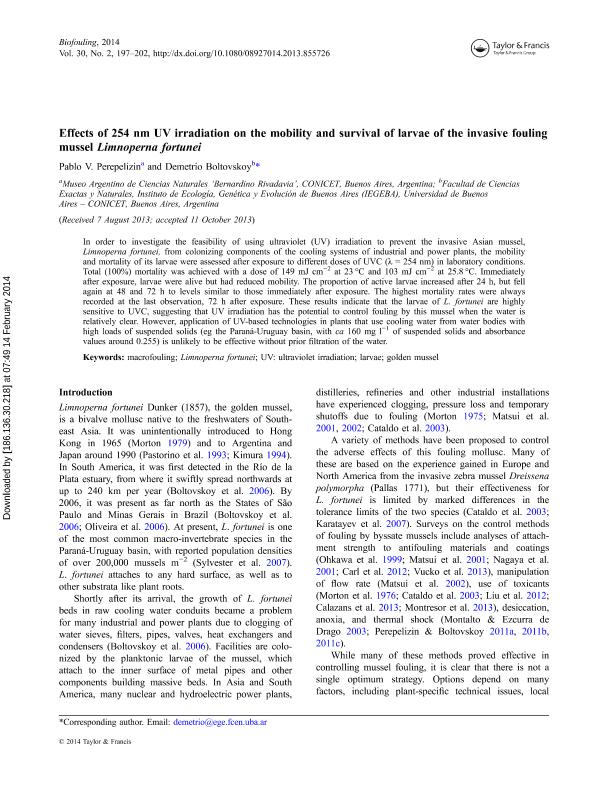Artículo
Effects of 254 nm UV irradiation on the mobility and survival of larvae of the invasive fouling mussel Limnoperna fortunei
Fecha de publicación:
04/2014
Editorial:
Taylor & Francis
Revista:
Biofouling
ISSN:
0892-7014
Idioma:
Inglés
Tipo de recurso:
Artículo publicado
Clasificación temática:
Resumen
In order to investigate the feasibility of using ultraviolet (UV) irradiation to prevent the invasive Asian mussel, Limnoperna fortunei, from colonizing components of the cooling systems of industrial and power plants, the mobility and mortality of its larvae were assessed after exposure to different doses of UVC (λ = 254 nm) in laboratory conditions. Total (100%) mortality was achieved with a dose of 149 mJ cm−2 at 23 °C and 103 mJ cm−2 at 25.8 °C. Immediately after exposure, larvae were alive but had reduced mobility. The proportion of active larvae increased after 24 h, but fell again at 48 and 72 h to levels similar to those immediately after exposure. The highest mortality rates were always recorded at the last observation, 72 h after exposure. These results indicate that the larvae of L. fortunei are highly sensitive to UVC, suggesting that UV irradiation has the potential to control fouling by this mussel when the water is relatively clear. However, application of UV-based technologies in plants that use cooling water from water bodies with high loads of suspended solids (eg the Paraná-Uruguay basin, with ca 160 mg l−1 of suspended solids and absorbance values around 0.255) is unlikely to be effective without prior filtration of the water.
Palabras clave:
Limnoperna Fortunei
,
Control
,
Uv
,
Biofouling
Archivos asociados
Licencia
Identificadores
Colecciones
Articulos(IEGEBA)
Articulos de INSTITUTO DE ECOLOGIA, GENETICA Y EVOLUCION DE BS. AS
Articulos de INSTITUTO DE ECOLOGIA, GENETICA Y EVOLUCION DE BS. AS
Articulos(MACNBR)
Articulos de MUSEO ARG.DE CS.NAT "BERNARDINO RIVADAVIA"
Articulos de MUSEO ARG.DE CS.NAT "BERNARDINO RIVADAVIA"
Citación
Perepelizin, Pablo Victor; Boltovskoy, Demetrio; Effects of 254 nm UV irradiation on the mobility and survival of larvae of the invasive fouling mussel Limnoperna fortunei; Taylor & Francis; Biofouling; 30; 2; 4-2014; 197-202
Compartir
Altmétricas




